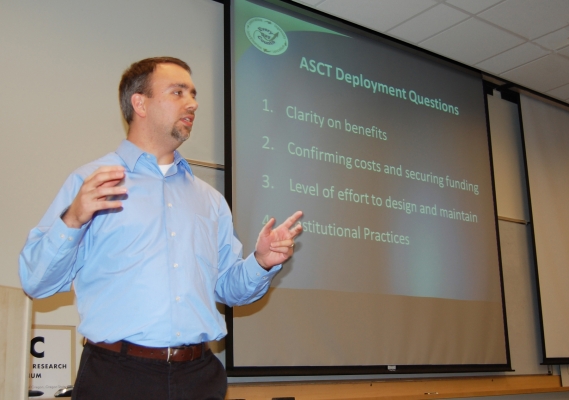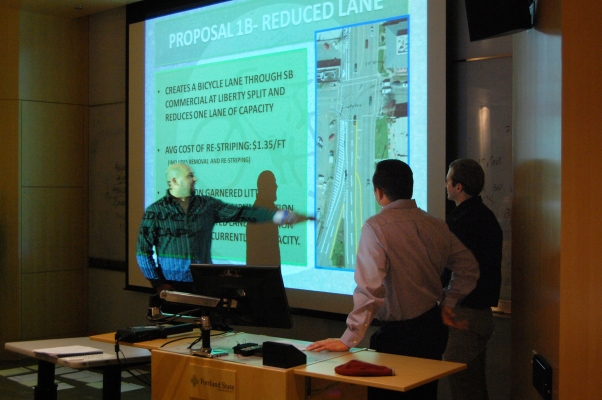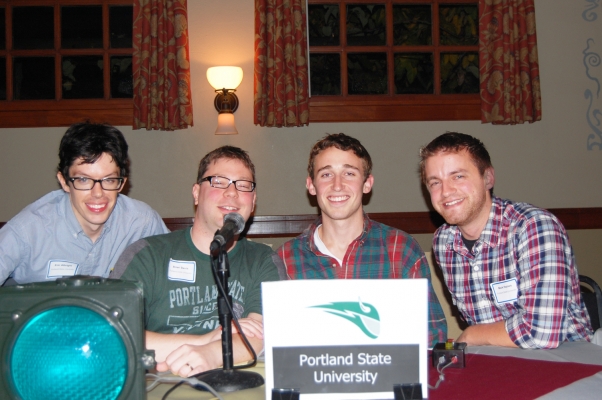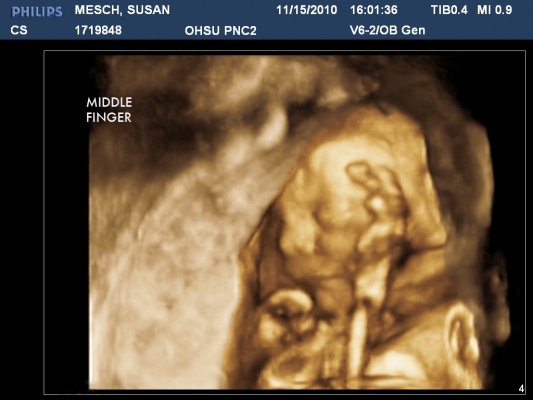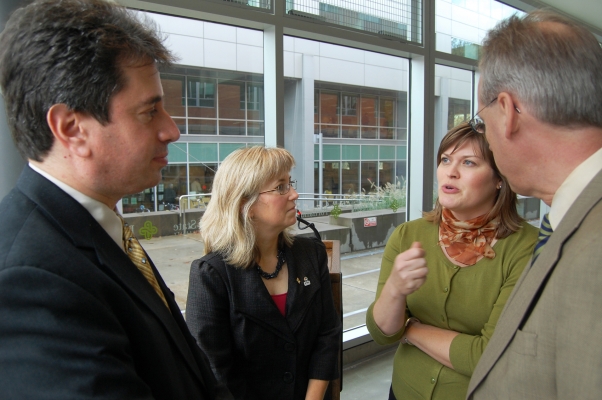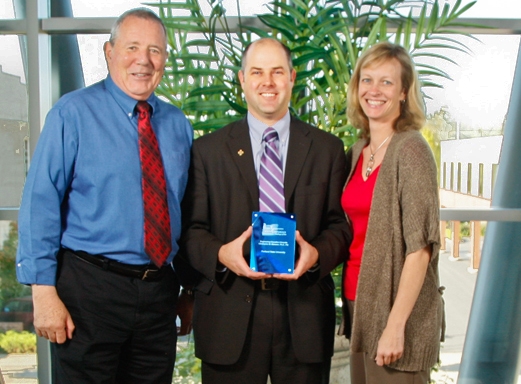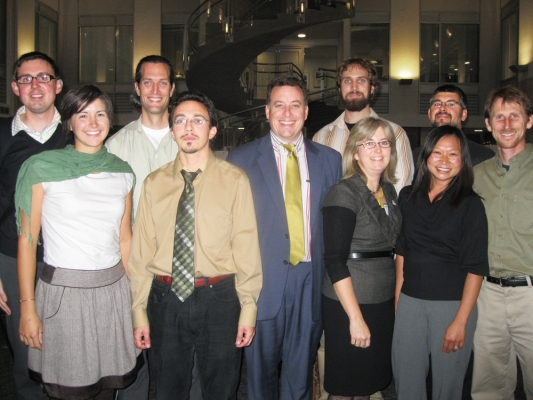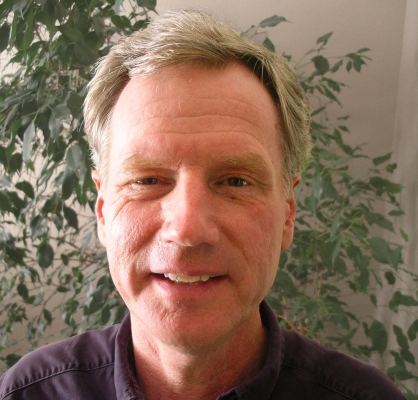Why build bigger when you can get more out of what you already have? That’s a question agencies across the country have considered as they face costly expansions of roadway systems or are unwilling or unable to keep building.
Adaptive signal control technologies offer the promise of reducing congestion, smoothing traffic flow and improving safety on existing roads. The Federal Highway Administration has been holding regional summits about this technology across the country.
Metro hosted one of the summits Dec. 1 at the Intelligent Transportation Systems (ITS) laboratory at Portland State University. Federal Highway Administration ITS specialists Paul Olson and James Colyar gave an overview of the technology, which can:
- Automatically adapt to changes in traffic
- Improve travel time reliability
- Reduce congestion and fuel consumption
- Monitor and respond to gaps in traffic signal operations
- Reduce complaints agencies get about bad signal timing
Adaptive technologies use data from sensors to adjust traffic lights, keeping the green light for as long as conditions warrant. The process updates in a few minutes what traditional signal retiming might accomplish only every few years.
The technology is best suited for arterials that receive variable or unpredictable traffic. On these roads, the signals can improve travel time, emissions and fuel consumption by 10 percent or more. Where signal timing has been...
Read morePortland State University transportation engineering students added their expertise to a yearlong effort to help Salem reinvent itself. The Urban Transportation Systems class looked at options to improve bicycle and pedestrian travel in the city’s downtown core.
The effort is part of the Sustainable Cities Initiative, one of three OTREC-funded initiatives. The initiative, led by co-directors Marc Schlossberg and Nico Larco at the University of Oregon, chooses one Oregon city per year to make its classroom, directing coursework to help the city adopt sustainable practices.
This year is the first to include Portland State University’s participation. Students in assistant Professor Chris Monsere’s Civil Engineering 454 class gave presentations Nov. 29 and Dec. 1 on several alternatives to improve bicycle and pedestrian transportation and safety. Projects included:
- Accommodating the bicycle and pedestrian crossing on Union Street at Commercial Street while considering impacts to automobile traffic
- Connecting cyclists and pedestrians at the end of the Union Street path at Wallace Road
- A bicycle and pedestrian route west of Wallace Road
- Converting selected one-way streets to two-way operation
- Traffic analysis of options drafted by bicycle advocates for the intersection of Commercial and Liberty streets at Vista Avenue ...
Portland State University’s Students in Transportation Engineering and Planning took first place in the Oregon Institute of Transportation Engineers’ William C. Kloos Traffic Bowl, held Nov. 18 at McMenamins Edgefield in Troutdale. The Oregon Institute of Technology’s ITE student chapter won third place.
Portland State’s victory at the 19th annual Traffic Bowl was its second in a row. The PSU team also finished third in the 2008 competition.
The Jeopardy-style tournament tests students on their knowledge of transportation engineering and history with a sprinkling of arcane facts and pop culture thrown in for good measure. Teams from Oregon State University, the University of Portland and the University of Washington also participated with the University of Portland placing second.
Lorem ipsum dolor sit amet, consectetur adipiscing elit. Morbi condimentum mollis tempus. Vivamus nulla mauris, mollis non condimentum quis, dapibus in neque. Ut eu mauris sit amet turpis hendrerit feugiat. Ut mattis ipsum lobortis arcu gravida fringilla. Maecenas leo lorem, adipiscing a pulvinar id, malesuada at nisl. Ut hendrerit imperdiet lacus nec eleifend. Quisque interdum, justo eget sollicitudin rutrum, tellus leo eleifend tellus, at egestas lorem augue fringilla leo. Nulla cursus arcu quis sem dignissim semper. Phasellus blandit eros at sem sagittis venenatis. Etiam a neque a sem porta tincidunt ut vitae neque. Ut vel commodo nulla. Duis leo nunc, tristique sed sagittis id, dapibus sed diam. Vestibulum urna nulla, lobortis non suscipit nec, sagittis sed metus. Quisque ut eros at enim aliquet scelerisque id ac augue. Nam tristique cursus tellus, in eleifend tortor ornare quis. Ut at felis risus, et sagittis diam. Duis blandit gravida sollicitudin.
Duis elit nulla, ultricies eget faucibus vitae, viverra in odio. Maecenas aliquet, orci non interdum fermentum, arcu orci blandit elit, id rhoncus erat orci ut mauris. Duis quis consequat elit. Ut non feugiat mauris. Pellentesque habitant morbi tristique senectus et netus et malesuada fames ac turpis egestas. Suspendisse potenti. Nullam ac mauris ipsum, vitae dictum elit. Quisque a tortor vitae ipsum porttitor ullamcorper. Vestibulum ante ipsum primis in faucibus orci luctus et ultrices posuere...
Good transportation decisions rely on good models. Yet, despite advances in transportation modeling, there had been no dedicated training ground for the next generation of modelers. That all changed with the launch of the Oregon Modeling Collaborative Nov. 12. The collaborative will serve as a living laboratory to put the research from some of America’s top modelers into practice across Oregon.
On Nov. 12, we welcomed Peter Appel, administrator of the federal Research and Innovative Technology Administration, to Portland to kick off the collaborative with researchers, practitioners and policymakers from across the Northwest. Appel, confirmed by the U.S. Senate as administrator in 2009, has worked on U.S. Department of Transportation initiatives aimed at getting researchers and professionals to address safety, efficiency and environmental sustainability across all forms of transportation.
Groundbreaking research at the Oregon Transportation Research and Education Consortium has already produced models to account for bicycle trips and greenhouse gas emissions and to predict earthquake risk to highway bridges. However, models don’t do any good if agencies can’t afford the staff time and resources to use them. The Oregon Modeling Collaborative helps fill this gap by educating the next...
Read moreChris Monsere, an assistant professor in Portland State University's Department of Civil and Environmental Engineering, received the "Engineering Education Advocate" award at the Oregon Transportation Safety Awards luncheon in Salem. The award was presented as part of the annual Oregon Transportation Safety Conference, sponsored by the Alliance for Community Traffic Safety and the Oregon Department of Transportation, or ODOT.
The award recognizes Monsere's teaching, research and service activities that have been geared toward improving the safety of Oregon's transportation system. Monsere has been the primary investigator on 11 OTREC projects, many of them related to safety. He's currently evaluating bike boxes designed to improve safety for cyclists. His other projects have focused on building a knowledge-based clearinghouse of safety-related data in Oregon and evaluating the effectiveness of ODOT's Safety Investment Program.
Students from OTREC programs gave the Oregon Transportation Commission their insights into the future of the transportation professions last week at a commission workshop in Bend. Students from Portland State University, the University of Oregon and Oregon State University joined OTREC researcher Kate Hunter-Zaworski on a panel aimed at providing the commission direction on its role in the changing transportation environment.
Hunter-Zaworski's presentation, "Aging in Place," focused on challenges an aging population places on public transit and other transportation systems. She recommended strategies to help older adults transition to transit use.
Student panelists offered the following:
- Joe Broach, a Ph.D. student in urban studies at Portland State, discussed the development of next-generation travel models in the Portland region, including the regional bike travel model and the DASH dynamic activity-based travel model.
- Kristin Kelsey, a University of Oregon architecture graduate student, discussed her work on site design, specifically on suburban multifamily sites.
- Mary Ann Triska, a civil engineering Ph.D. student at Oregon State, discussed the role of civil engineers as public servants and the importance of both design and rules for different travel modes on shared roadways.
Themes that emerged from the panel include the importance of considering smaller-scale transportation planning, how to safely share road space...
Read moreTen OTREC researchers, staff, and students participated in the Transportation Research Board and University Transportation Center Transportation Systems for Livable Communities Conference last week in Washington, D.C. The conference brought together researchers and practitioners from transportation, housing and public health.
Highlights of the conference included an insightful discussion on defining livability. Despite inconclusive debate on the definition, participants agreed that for the concept to be embraced it can neither be dictated nor prescribed. Performance measures also were a recurring theme of the two-day conference. Concepts explored included: re-evaluating outdated measures such as volume-to-capacity ratio and level of service to better reflect different modes, shifting thinking from mobility to accessibility and proximity, and data standardization and measurement methodologies. To complete the livability picture, the multigenerational and socioeconomic considerations need to be included.
The following four OTREC research projects were highlighted during the conference poster session:
- Implementation of Active Living Policies by Land Use and Transportation Agencies: Jennifer Dill, Oregon...
Oregon State University student Lacy Brown's presentation won top honors at the Oregon Transportation Safety Conference, held Oct. 12 to 14 in Salem. Brown's presentation was titled "Assessment of Statewide Intersection Safety Performance," an Oregon Department of Transportation Resesarch-sponsored project.
Kristie Gladhill of Portland State University and Jon Mueller and Raul Avelar, both of Oregon State, also presented at the conference, which is put on by the Alliance for Community Traffic Safety Oregon.
Presentations lasted around 20 minutes and were judged on three criteria: process, product and presentation:
- Process: The research project is rigorous, with good data and solid analysis.
- Product: The student's findings will be valuable for the profession.
- Presentation: The student communicated the information clearly and professionally.
OTREC provided each student with $200 for travel and will award Brown $350 for her winning presentation.
When engineers focus on transportation systems, they often produce brilliant solutions. Sometimes, however, they focus in the wrong place.
“Engineers are really good; if you tell them, ‘This is what we want to accomplish,’ they’ll do it,” said Peter Jacobsen, himself an engineer and a public health consultant. “But traffic safety hasn’t had a good scientific, evidence-based approach that we have in, say, nuclear-power-plant design.”
Jacobsen, Portland State University’s first visiting scholar this school year, will present the Vision Zero concept at Friday’s transportation seminar. Vision Zero resets the goal of transportation systems from reducing total crashes to eliminating fatalities.
“The way engineers currently look at the road system is to look at crashes,” Jacobsen said. “Vision Zero folks say to look at health: not to have fatalities or permanent disabling injuries.”
Designing for health means respecting the limits of the human body. If crossing into oncoming traffic could produce head-on collisions with a greater force than people could survive, then Vision Zero says to separate that traffic. Roundabouts reduce the likelihood of dangerous side-impact collisions.
Vision Zero could have the largest effect closer to home. Jacobsen has pushed for colleagues to consider traffic from a child’s perspective. A residential street that might be...
Read more
